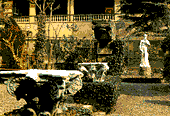
The Museum garden
The Museum is situated in Palazzo della Crocetta (with its unusual design
in the shape of the cross), which was built by Giulio Parigi for the
Archduchess Maria Maddalena d'Austria (1620). Entrance is
from Via della Colonna near piazza SS.Anunziata,
where there is also a railed-off garden containing several Etruscan tombs
that have been recomposed using as much of the original material as possible.
It is one of the most important museums in the world on the art and civilization
of the Etruscans, though it also contains many fine examples of Greek
art. The important Egyptian Museum is situated on the first floor, the second
in Italy after the one in Turin; the collection was formed by the Nizzoli
and Schiapparelli collections together with the series of excavations
carried out between 1828-29 by Ippolito Rossellini with François
Champollion, the scholar who decoded hieroglyphics.
One of the famous victims of the 1966 flood, the museum has since been carefully
restored and is now able to exhibit all its treasures to the public.

The Etruscan bronze Chimera
(V-IV sec.a.C.)
The collection originated with the Medici Collections (from
the time of Cosimo the Elder) and was
then further enriched by the Lorraine family and
exhibited in the Uffizi until 1888, when it was
moved to Palazzo Crocetta. Some of the most famous works it contains
are: the la Chimera, a bronze masterpiece of
Etruscan sculpture (V-IV century B.C.), discovered in 1553 in the countryside
near Arezzo and restored by Benvenuto Cellini;
the huge silver Amphora of Baratti (IV century B.C.) decorated with
about 130 images of Gods and heroes; the Arringatore, the large bronze
portrait (I century B.C.) of the Etruscan nobleman Aule Metelle discovered
in 1566 near the Lake of Trasimeno;
the Little Idol, a rare Greek bronze (V century B.C.) found in Pesaro
in 1530, which still has the Renaissance base added to it when it
became part of the Medici collections; the Greek Torso of an
Athlete (V century B.C.) is Greek, as also the Head of a Horse from
the Hellenistic period which was to inspire Donatello and Verrocchio
for the two famous equestrian monuments in Padua and Venice.

François Vase 570 a.C.
The most famous among the huge collection of vases is the Francois Vase, signed by Ergotimos and the painter Kleitias, dated 570 B.C. It was found near Chiusi in 1844 and its complex "black figure" decorations make it one of the most important examples of the figurative and mythological Greek culture exported to Etruria. The collection of funeral urns also includes the Mater Matuta from Chiusi (V century B.C.), the Goddess of Dawn, which is considered almost an archetype of the Christian Madonna and Child; the Sarcophagus of Larthia Seianti (II century B.C.), a polychromatic terracotta found at Chiusi; the Sarcophagus of Amazzoni (IV century B.C.) and the so-called Sarcophagus of the Fat Man (Chiusi, II century B.C.).
